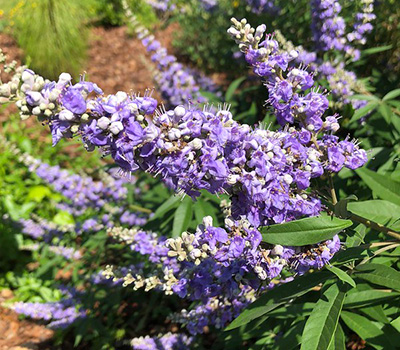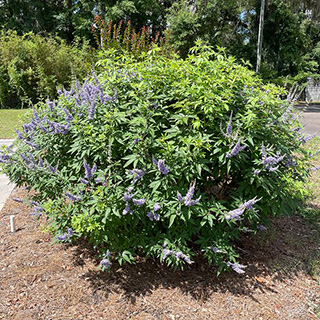Chastetree

Also called vitex (Vitex agnus-castus), chastetree is a large, deciduous flowering shrub or small tree. It puts on a show from late spring through fall with its beautiful bluish-purple flowers clustered along tall spikes.
The curious name, “chastetree” finds its roots in a Roman book, Naturalis Historia. This early natural history text was written in the first century AD. The author was Pliny the Elder, a noted naturalist, writer, and military commander of the early Roman empire. He notes that women in Athens kept branches of the tree under their beds during the feast of Ceres, the Roman goddess of agriculture, grain, and fertility. These young women believe the leaves of the plant would help them remain pure, thus the “chastetree”. Pliny also notes the origin of another of this plant’s names: vitex. The name vitex comes from the Latin vieo, meaning to weave. Pliny believed this name was connected to the tree’s use in Roman basket weaving.
Characteristics
Vitex features sage-scented gray-green leaves. These soft colors make it a good background for other, brighter landscape plants. It can be planted wherever a smaller tree might enhance the landscape, even in a planter! The compound leaves and gray bark also make this plant a beautiful addition to a shrubbery border.
The wide variety of vitex cultivars offer a choice in flower color. ‘Silver Spire’ and ‘Alba’ have white flowers while ‘Rosea’ has pink flowers. ‘Shoal Creek’ boasts show-stopping purple blooms while ‘Purpurea’ cultivars have delicate lilac flowers.
Another attractive feature of vitex is its ability to attract wildlife. Although not a Florida native species, native butterflies and hummingbirds feed on the nectar. Its tasty seeds will even attract small birds. It is also attractive to bees and encourages excellent honey production in neighboring hives.
Planting and Care

Florida gardeners should plant chastetree in full sun or partial shade. Be sure to leave it room to grow, since this vase-shaped plant can reach 10 to 15 feet tall and 15 to 20 feet wide. Plants develop low, drooping branches when left unpruned. If you have a specific shape in mind, some pruning may be necessary.
Vitex is deciduous and may lose its leaves after a cold frost. This should not worry gardeners. It will not remain bare for long, thanks to a fast growth rate. Harder freezes may result in some dieback and damage but thankfully for gardeners from Pensacola to Miami this plant is cold-hardy in zones 7b-11. These trees are also highly drought tolerant once they’ve adjusted to their new location and are also fairly tolerant of salt spray.
In your landscape this plant will grow best in loose, well-drained soil that is a bit on the dry side. In organic, mucky, or moist soils chastetree can suffer from dieback and root rot. It has no major pest concerns and, aside from leaf spot, suffers from no common plant diseases.
Vitex is a non-native species but is not considered invasive by the UF/IFAS assessment of non-native plants. Still, seeds may colonize nearby landscape beds and become weedy. If you’d like more of this attractive plant in your landscaping, these seedlings can be moved to a better location. Vitex can also be reproduced by cuttings.
